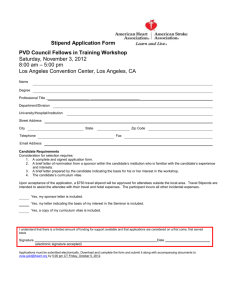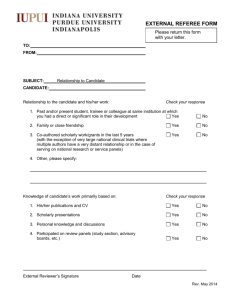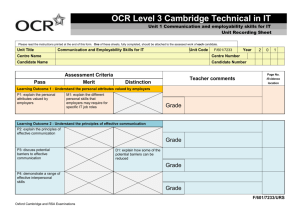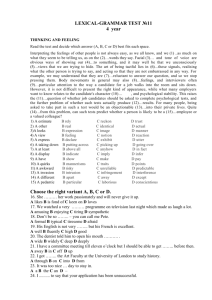0530_s13_ms_23 184.99KB 2015-09
advertisement
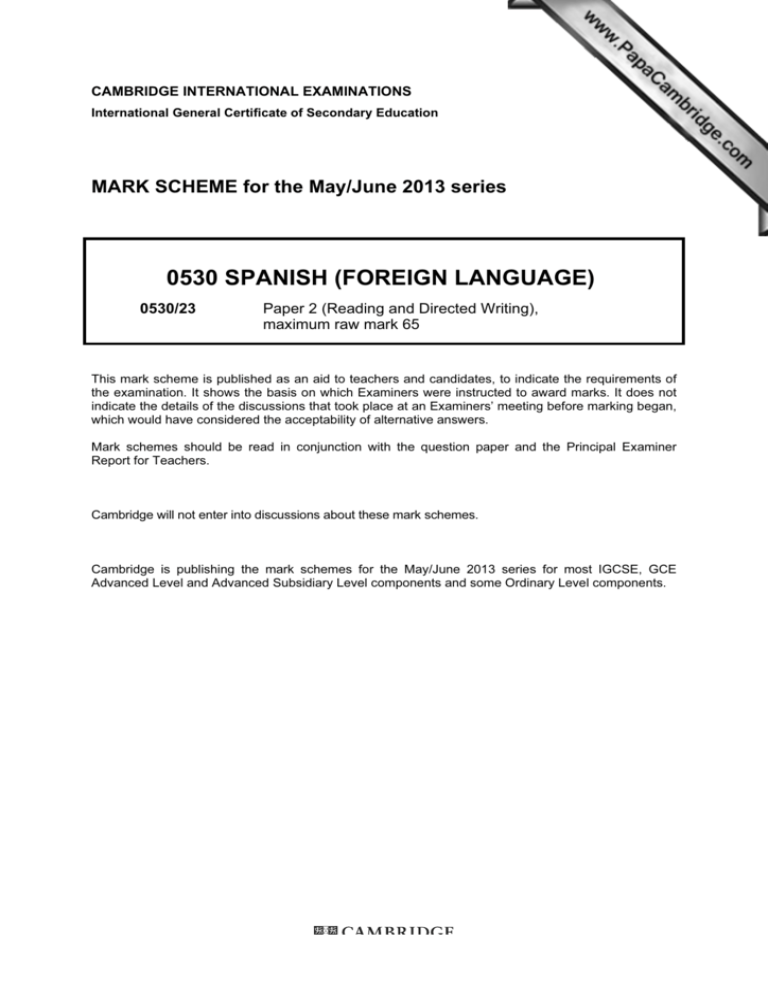
CAMBRIDGE INTERNATIONAL EXAMINATIONS International General Certificate of Secondary Education MARK SCHEME for the May/June 2013 series 0530 SPANISH (FOREIGN LANGUAGE) 0530/23 Paper 2 (Reading and Directed Writing), maximum raw mark 65 This mark scheme is published as an aid to teachers and candidates, to indicate the requirements of the examination. It shows the basis on which Examiners were instructed to award marks. It does not indicate the details of the discussions that took place at an Examiners’ meeting before marking began, which would have considered the acceptability of alternative answers. Mark schemes should be read in conjunction with the question paper and the Principal Examiner Report for Teachers. Cambridge will not enter into discussions about these mark schemes. Cambridge is publishing the mark schemes for the May/June 2013 series for most IGCSE, GCE Advanced Level and Advanced Subsidiary Level components and some Ordinary Level components. Page 2 Mark Scheme IGCSE – May/June 2013 1 General Marking Notes 2 General Marking Principles Syllabus 0530 Paper 23 2.1 Please note that it is not possible to list all acceptable alternatives in the Detailed Mark Scheme provided in Section 3. You will need to consider all alternative answers and unexpected approaches in candidates’ scripts, make a decision on whether they communicate the required elements, in consultation with your Team Leader if necessary (or with your Product Manager if you are a single Examiner), and award marks accordingly. The following marking principles underpin the detailed instructions provided in Section 3 of the Mark Scheme. Where a decision is taken to deviate from these principles for a particular question, this will be specified in the Mark Scheme. 2.2 Crossing out: (a) If a candidate changes his/her mind over an answer and crosses out an attempt, award a mark if the final attempt is correct. (b) If a candidate crosses out an answer to a whole question but makes no second attempt at it, mark the crossed out work. 2.3 Reading tasks: more than the stipulated number of boxes ticked/crossed by the candidate: (a) If more than one attempt is visible, but the candidate has clearly indicated which attempt is his/her final answer (e.g. by crossing out other attempts or by annotating the script in some way), mark in the usual way. (b) If two attempts are visible (e.g. two boxes ticked instead of the 1 box stipulated), and neither has been crossed out/discounted by the candidate, no mark can be awarded. (c) In questions where candidates are required to tick a number of boxes (e.g. tick the 6 true statements) the general rule to be applied is as follows: the number of ‘extra’ answers indicated by the candidate is deducted from the number of correct answers and the remaining number is the mark awarded, e.g. the candidate is required to tick 6 true statements, but instead ticks 8 statements. 5 of the 6 ticks are correctly placed, but 2 of the ticks are ‘extras’ (8 ticks placed by candidate minus 6 ticks required by rubric = 2). Therefore the candidate is awarded a mark of 3. 5 –2 = 3 number of correct ticks minus number of extra ticks (d) Answers in pen do not take precedent over answers in pencil, e.g. if a candidate is asked to tick 1 box and ticks two, one in pen and the other in pencil, the mark cannot be awarded unless there is some explicit indication from the candidate as to which is his/her final answer. 2.4 Reading tasks: for questions requiring more than one element for the answer, (i) and (ii), where the answers are interchangeable: Both correct answers on line 1 and line 2 blank = 2 Both correct answers on line 1 and line 2 wrong = 1 (or vice-versa) © Cambridge International Examinations 2013 Page 3 Mark Scheme IGCSE – May/June 2013 Syllabus 0530 Paper 23 2.5 Reading tasks: answers requiring the use of Spanish (rather than a non-verbal response) should be marked for communication. Tolerate inaccuracies provided the message is clear. (a) ‘If in doubt, sound it out’: if you read what the candidate has written, does it sound like the correct answer? (b) Look-alike test: does what the candidate has written look like the correct answer? (c) Accept incorrect gender or person unless Mark Scheme specifies otherwise. (d) Accept incorrect possessive adjectives e.g. mi, tu, su, unless Mark Scheme specifies otherwise (in general, Section 2 accept, Section 3 consult Mark Scheme carefully). 2.6 Unless the Mark Scheme specifies otherwise, do not accept incorrect Spanish if the word given means something else in Spanish. (Incorrect Spanish which constitutes a word in any language other than Spanish is marked (i) on the basis of whether it is accepted or refused in the Mark Scheme and (ii) if not mentioned in the Mark Scheme, on the basis of 2.5 above). 2.7 Annotation used in the Mark Scheme: (a) INV = Invalidation and is used when additional material included by the candidate is judged to invalidate an otherwise correct answer thus preventing him/her from scoring the mark (INV = 0). (b) tc = ‘tout court’ and means that on its own the material is not sufficient to score the mark. (c) HA = harmless additional material which in conjunction with the correct answer does not prevent the candidate from scoring the mark. (d) BOD = Benefit of the Doubt and is used to indicate material considered by the Examiner and judged to be more correct than incorrect: the benefit of the doubt is given to the candidate and the mark is awarded. 2.8 No response and ‘0’ marks There is a NR (No Response) option in scoris. Award NR (No Response): • If there is nothing written at all in the answer space or • If there is only a comment which does not in any way relate to the question being asked (e.g. ‘can’t do’ or ‘don’t know’) or • If there is only a mark which isn’t an attempt at the question (e.g. a dash, a question mark). Award 0: • If there is any attempt that earns no credit. This could, for example, include the candidate copying all or some of the question, or any working that does not earn any marks, whether crossed out or not. © Cambridge International Examinations 2013 Page 4 Mark Scheme IGCSE – May/June 2013 Syllabus 0530 Paper 23 2.9 Extra material: Section 2, Exercise 1 In Section 2, Exercise 1, reward the candidate for being able to locate the answer in the passage. Do not worry about lifting unless a lift is specifically rejected in the Mark Scheme. Unless the Mark Scheme states otherwise, ignore extra material given in an answer. 2.10 Extra material: Section 3 In Section 3 it is the candidate’s responsibility to answer questions in such a way as to demonstrate to the Examiner that s/he has understood the texts/questions. Where candidates introduce extra, irrelevant material to an otherwise correct answer the danger is that the Examiner is being forced to ‘choose’ the correct answer and s/he cannot be certain that the candidate has shown understanding. Where the Examiner is put in this position the mark cannot be awarded. In Section 3, look for signs of genuine comprehension. Usually, candidates who lift indiscriminately fail to demonstrate comprehension and will not score the mark. However, careful lifting of the details required to answer the question does demonstrate comprehension and should be rewarded. The Detailed Mark Scheme (Section (3)) provides specific guidance but in cases not covered, the following general rules apply: (a) Extra material, mentioned in the Mark Scheme, which reinforces the correct answer or in itself constitutes an alternative correct answer: this is acceptable and is not penalised (b) Extra material which constitutes an alternative answer, but which is not explicitly mentioned in the Mark Scheme: the Examiner needs to decide, by consulting the text and the Team Leader if necessary whether the alternative answer constitutes: (i) an alternative correct answer, in which case this falls into category (a) and the answer should be rewarded (ii) or an answer which on its own would be refused, in which case this falls into category (c) and the answer should be refused (c) Extra material which constitutes an alternative answer specifically refused in the Mark Scheme: this puts the Examiner in the position of having to ‘choose’ which is the candidate’s ‘final’ answer – the Examiner cannot be sure what the candidate has understood – and the mark cannot be awarded (d) Extra material which distorts or contradicts the correct answer: this affects communication – the Examiner cannot be sure what the candidate has understood – and the mark cannot be awarded (e) Extra material introduced this affects communication – the Examiner cannot be sure what by the candidate and which the candidate has understood – and the mark cannot be does not feature in the text: awarded. It can sometimes be difficult to draw the line between what is a deduction made by an able candidate on the basis of what they have read and pure guesswork. Therefore where an answer of this sort occurs which is not covered in the Mark Scheme, Examiners should consult their Team Leader © Cambridge International Examinations 2013 Page 5 3 Mark Scheme IGCSE – May/June 2013 Syllabus 0530 Paper 23 Detailed Mark Scheme Sección 1 Ejercicio 1 Preguntas 1–5 1 A 1 2 A 1 3 C 1 4 D 1 5 C 1 [Total: 5] Ejercicio 2 Preguntas 6–10 6 F 1 7 E 1 8 B 1 9 C 1 10 D 1 [Total: 5] Ejercicio 3 Preguntas 11–15 11 B 1 12 C 1 13 B 1 14 B 1 15 C 1 © Cambridge International Examinations 2013 [Total: 5] Page 6 Mark Scheme IGCSE – May/June 2013 Syllabus 0530 Paper 23 Ejercicio 4 Pregunta 16 COMMUNICATION: 1 mark per item up to a maximum of 3 APPROPRIATENESSS OF LANGUAGE: 0, 1 or 2 marks according to grid • Mark answers written in note form (e.g. where candidates answer ALL the questions but ignore the instruction to frame their answer as a message) as follows: • (a) campo (b) amigos (c) escuchar música = 1 for COMMUNICATION and 0 for APPROPRIATENESS • Mark answers not written in the space provided exactly as those written in the correct space • Vas al campo; estás con tus amigos; pasas el tiempo a escuchar música = 2 for COMMUNICATION (candidate loses mark for first “tú” but not for repeated error) and 0 for APPROPRIATENESS Communication ACCEPT REFUSE FOR COMMUNICATION ACCEPT ANY TENSE Spelling: use rules in 2.5, look alike, sound alike, etc. (a) ADÓNDE VAS Accept voy/vamos + al campo IGNORE: mention of a specific place, e.g. voy al campo en Madrid (ignore “en Madrid”, scores for “al campo”) IGNORE: preposition or lack of before “campo”, e.g. voy campo = 1 (b) CON QUIÉN ESTÁS Accept estoy/estamos + con mis amigos/primos/hermanos/mi colegio etc IGNORE: preposition or lack of before “amigos”, e.g. estoy mis amigos = 1 (c) CÓMO PASAS EL TIEMPO Accept paso/pasamos + el tiempo a escuchar música Accept escucho/escuchamos música, voy/vamos a escuchar música refuse voy en Madrid tc (no mention of campo etc) refuse voy al camping tc (no mention of campo etc) refuse soy al camping tc (no mention of campo etc) refuse estoy con mi perro/mi gato refuse any other activity © Cambridge International Examinations 2013 Page 7 Mark Scheme IGCSE – May/June 2013 Syllabus 0530 Paper 23 For LANGUAGE, consider only the parts of Appropriateness of language the candidate’s work for which you NB: if candidates do not attempt one of the tasks they cannot score more than 1 mark for language. award a communication mark: Yo ir al campo. Estoy con mi perro. Yo escuchar 2 For the award of 2 marks, 2 verbs must be in música = 2 for comm. + 0 for lang. appropriate tenses / forms. Minor errors (adjective endings, use of prepositions etc.) are For LANGUAGE accept any verb tense/ form tolerated. as long as the sequence follows a logical fashion. 1 There is some appropriate usage to reward. For the award of 1 mark, 1 verb must be in an appropriate tense. 0 There are no examples of appropriate usage to reward. Where 0 awarded for Communication, 0 marks awarded for language. [Total: 5] © Cambridge International Examinations 2013 Page 8 Mark Scheme IGCSE – May/June 2013 Syllabus 0530 Paper 23 Sección 2 Ejercicio 1 Preguntas 17–25 • • • • • In this exercise, reward the candidate for being able to locate the answer in the passage. IGNORE EXTRA MATERIAL (whether Spanish is accurate or inaccurate) Accept lifting unless it is specifically refused in the Mark Scheme. READ SECTION 2: GENERAL MARKING PRINCIPLES, IN PARTICULAR, 2.1, 2.2, 2.4, 2.5, 2.6, 2.7, 2.8, 2.9 Accept mi, mis, tu, tus, su, sus etc. and él throughout for Andrés/Fernando ACCEPT 17 (al) terminar sus/los estudios / después de sus/los estudios / cuando termine sus/los estudios 18 profesor / dando clases / trabajó en una escuela / tres meses en una escuela REFUSE 1 en una escuela dando 1 19 (la experiencia) ha cambiado su vida (por completo) 1 20 se enfadan / no quieren que vaya / no les gusta que vaya 1 no quieran / tienen miedo / no les gusta no necesito (ir lejos de casa) tc 21 hay muchos grupos que ayudan aquí en su/mi país / ayudar cerca de su casa / no necesito/necesita ir lejos para ayudar 1 22 tienen miedo 1 23 conocer otro país / (para) ayudar (al mismo tiempo) / viajar a otros países 1 se enfadan © Cambridge International Examinations 2013 Page 9 Mark Scheme IGCSE – May/June 2013 24 (i) (por) la charla de Fernando / (por) los vídeos de Fernando / Fernando va a mostrar vídeos (en el colegio) Fernando va a dar una charla (en el colegio, mostrando los vídeos que sacó) 1 (ii) (Andrés) va a llevar a sus/los padres (a ver el vídeo / a la charla) 1 Syllabus 0530 Paper 23 Fernando habla/hablará con sus padres Fernando charla/charlará con sus padres NB 2 correct answers on line 1, line 2 blank = 2; 2 correct answers on line 1, line 2 wrong = 1 (or vice versa) 25 (viajes) ecológicos / para trabajar con animales en peligro animales tc 1 [Total: 10] © Cambridge International Examinations 2013 Page 10 Mark Scheme IGCSE – May/June 2013 Syllabus 0530 Paper 23 Ejercicio 2 Pregunta 26: Tu dormitorio • COMMUNICATION: 1 mark per item up to a maximum of 10 • ACCURACY: up to 5 marks according to banded mark scheme IGNORE TITLES, LETTER HEADINGS & ENDINGS FOR COMMUNICATION AND ACCURACY Communication : FOR COMMUNICATION BE TOLERANT OF VERBS / TENSES / SPELLING Award marks flexibly across the tasks. HOWEVER, each of the 4 tasks, (a), (b), (c), (d) must be covered to get the 10 communication marks. If (a) or (b) or (c) or (d) is missing, the maximum communication mark is 9. If 2 of (a) or (b) or (c) or (d) are missing, the maximum communication mark is 8. LISTS = a maximum of 3 marks for communication: lists of 1–3 items = 1 mark; lists of 4 items = 2 marks; lists of 5–6 items = 3 marks Estudio francés, español e historia = 1 mark (1 verb = a list of 3) ONLY REWARD EACH ELEMENT ONCE ACCEPT (a) cómo es tu dormitorio REWARD: what the candidate’s bedroom is like, e.g. es grande (b) lo que haces en tu dormitorio REWARD: what the candidate does in his/her bedroom, e.g. veo la televisión (c) si te gusta tu dormitorio o no, y por qué 1 mark for saying whether or not they like their bedroom 1 mark for why ACCEPT: (no) me gusta mi dormitorio REWARD: reason why (whether or not it is clear that they like their bedroom or not) (d) cómo sería tu dormitorio ideal REWARD: what the candidate’s ideal bedroom would be like, e.g. sería más precioso © Cambridge International Examinations 2013 REFUSE Page 11 Mark Scheme IGCSE – May/June 2013 Syllabus 0530 Paper 23 Accuracy 5 Straightforward vocabulary and structure. The style of writing is basic, but reasonably coherent. Use of a limited range of verbs, generally successful. More accuracy than inaccuracy. 4 Basic vocabulary and structure. Some awareness of verb usage, but inconsistent. The writing is sufficiently accurate for meaning to be conveyed. 3 Very basic vocabulary and structure. Little awareness of verb usage (e.g. infinitives regularly used instead of finite verbs). Despite regular errors, the writing often conveys some meaning. 2 A few phrases or short sentences are accurate enough to be recognisable. Very simple sentence structure. 1 Disjointed words or short phrases, one or two of them accurate enough to be comprehensible. 0 Nothing accurate enough to be comprehensible. [Total: 15] © Cambridge International Examinations 2013 Page 12 Mark Scheme IGCSE – May/June 2013 Syllabus 0530 Paper 23 Sección 3 Look for signs of genuine comprehension. Usually, candidates who lift indiscriminately fail to demonstrate comprehension and will not score the mark. However, careful lifting of the details required to answer the question does demonstrate comprehension and should be rewarded. The Detailed Mark Scheme (Section (3)) provides specific guidance but in cases not covered, see General Marking Principles, Section 2.10. Ejercicio 1 Preguntas 27–32 1 Mark per question for True or False 1 Mark for correcting False statement (27, 28, 30, 31) First award marks for the True/False element and then award marks for the justification of the False statements. VERDADERO FALSO 27 1 28 1 29 1 30 1 31 1 32 1 © Cambridge International Examinations 2013 Page 13 Mark Scheme IGCSE – May/June 2013 ACCEPT: CHECK FALSO IS TICKED Syllabus 0530 Paper 23 REFUSE MERE ADDITION OF NEGATIVE 27 solo llevan cuatro / solo llevan un poco/algunos de todo lo que compran 1 compramos zapatos y ni siquiera nos los ponemos / los ponemos ni una vez / 19 son los pares … cuatro 28 en Europa / de toda Europa / Elena tiene fama de ser la mujer que tiene la colección más grande de toda Europa / (tiene) la colección de zapatos más grande de toda Europa 1 más grande de toda Europa 30 los tuvo que esconder (de sus padres) / solo se los pudo poner en casa de su amiga los tuvo/tuve que esconder de mis padres / sus padres detestan los zapatos 1 31 nunca se la pierde/pierdo / Elena asiste a la convención cada año 1 nunca me la/le/lo pierdo [Total: 10] © Cambridge International Examinations 2013 Page 14 Mark Scheme IGCSE – May/June 2013 Syllabus 0530 Paper 23 Ejercicio 2 Preguntas 33–41 ACCEPT 33 vestidos (raros) / un local fuera de lo normal / (se casan) debajo del agua / tener una boda en el espacio 34 forman parte de un grupo que deseaban/desean hacer un evento inolvidable (en todo sentido) / son más aventureros que (las) otras parejas 35 celebrar la boda en el espacio / casarse en el espacio / casarse en una nave espacial REFUSE 1 puede ser original la boda como debajo del agua / otros buscan un local fuera de lo normal / en un vuelo sobre la Florida prefieren ir aun más allá / porque es un evento inolvidable en todo sentido / son aventureros tc 1 1 36 se celebró la boda en un avión/un vuelo/flotando como astronautas en un avión (sobre Florida) 1 tenía desde siempre la idea de … espacio / flotando como astronautas en una nave espacial / (fue) una nave espacial / en el espacio la solución fue una boda flotando (como astronautas) 37 el avión tuvo que subir y bajar (a gran en un avión que subía / altura) 1 en un avión que bajaba 38 el intercambio de los anillos 1 el intercambio tc 39 por/a causa de la inestabilidad 1 porque es bastante complicado tc / es inestabilidad 40 (a) (los novios) llevaban un traje negro y un vestido blanco / no llevaban ropa de astronauta / los novios no estaban vestidos de astronautas / los novios eran tan elegantes 1 el vestido blanco/el traje negro tc / que ella pensaba verlos vestidos de astronautas / son tan elegantes 40 (b) (Sandra/ella llevaba los) pendientes con forma de planetas 1 llevaban (unos) pendientes con forma de planetas 41 (solo) necesitas/se necesita la ayuda de una la ayuda / de las (varias) compañías / un precio elevado / (tienes que) pagar un precio elevado / personal opinion of the candidate (tienes que) pagar más que (lo) normal 1 [Total: 10] © Cambridge International Examinations 2013
